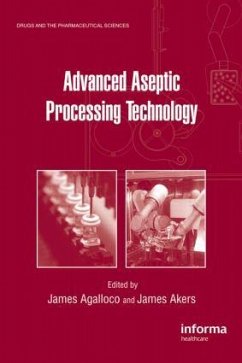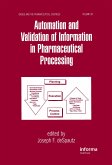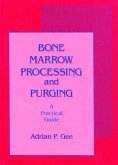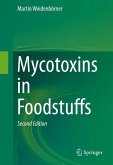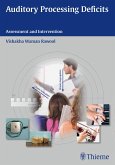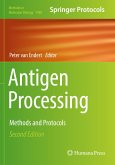Advanced Aseptic Processing Technology
Herausgeber: Agalloco, James; Akers, James
Advanced Aseptic Processing Technology
Herausgeber: Agalloco, James; Akers, James
- Gebundenes Buch
- Merkliste
- Auf die Merkliste
- Bewerten Bewerten
- Teilen
- Produkt teilen
- Produkterinnerung
- Produkterinnerung
New approaches that transform classical aseptic production methods appear almost daily. This book reviews emerging technologies for aseptic processing that will markedly reduce the level of contamination risk for sterile products. It discusses the use of isolator and barrier concepts for aseptic processing and assembly, the use robotics as an alternative to gowned personnel, increasing reliance on automation to minimize or eliminate operator intervention, and the design, operational, monitoring and compliance changes necessary for success with advanced aseptic processing.
Andere Kunden interessierten sich auch für
![Automation and Validation of Information in Pharmaceutical Processing Automation and Validation of Information in Pharmaceutical Processing]() Joseph F. DespautzAutomation and Validation of Information in Pharmaceutical Processing240,99 €
Joseph F. DespautzAutomation and Validation of Information in Pharmaceutical Processing240,99 €![Ice Cream Ice Cream]() Wendell S. ArbuckleIce Cream53,99 €
Wendell S. ArbuckleIce Cream53,99 €![The Rules of Aseptic and Antiseptic Surgery, Volume 2 The Rules of Aseptic and Antiseptic Surgery, Volume 2]() Arpad Geyza GersterThe Rules of Aseptic and Antiseptic Surgery, Volume 237,99 €
Arpad Geyza GersterThe Rules of Aseptic and Antiseptic Surgery, Volume 237,99 €![Bone Marrow Processing and Purging Bone Marrow Processing and Purging]() Adrian P. GeeBone Marrow Processing and Purging370,99 €
Adrian P. GeeBone Marrow Processing and Purging370,99 €![Mycotoxins in Foodstuffs Mycotoxins in Foodstuffs]() Martin WeidenbörnerMycotoxins in Foodstuffs150,99 €
Martin WeidenbörnerMycotoxins in Foodstuffs150,99 €![Auditory Processing Deficits Auditory Processing Deficits]() Auditory Processing Deficits64,99 €
Auditory Processing Deficits64,99 €![Antigen Processing Antigen Processing]() Antigen Processing82,99 €
Antigen Processing82,99 €-
-
-
New approaches that transform classical aseptic production methods appear almost daily. This book reviews emerging technologies for aseptic processing that will markedly reduce the level of contamination risk for sterile products. It discusses the use of isolator and barrier concepts for aseptic processing and assembly, the use robotics as an alternative to gowned personnel, increasing reliance on automation to minimize or eliminate operator intervention, and the design, operational, monitoring and compliance changes necessary for success with advanced aseptic processing.
Produktdetails
- Produktdetails
- Verlag: CRC Press
- Seitenzahl: 494
- Erscheinungstermin: 23. Juli 2010
- Englisch
- Abmessung: 260mm x 183mm x 31mm
- Gewicht: 1115g
- ISBN-13: 9781439825433
- ISBN-10: 1439825432
- Artikelnr.: 27246997
- Herstellerkennzeichnung
- Libri GmbH
- Europaallee 1
- 36244 Bad Hersfeld
- gpsr@libri.de
- Verlag: CRC Press
- Seitenzahl: 494
- Erscheinungstermin: 23. Juli 2010
- Englisch
- Abmessung: 260mm x 183mm x 31mm
- Gewicht: 1115g
- ISBN-13: 9781439825433
- ISBN-10: 1439825432
- Artikelnr.: 27246997
- Herstellerkennzeichnung
- Libri GmbH
- Europaallee 1
- 36244 Bad Hersfeld
- gpsr@libri.de
James Agalloco is President of Agalloco & Associates. Since the formation of Agalloco & Associates in 1991, Jim has assisted more than 100 firms in the areas of validation, sterilization, aseptic processing and compliance. . He is a past President of the Parenteral Drug Association and a member of United States Pharmacopeia's Microbiology and Sterility Assurance Expert Committee since 2005. He has authored or co-authored 43 book chapters and over 100 papers, and has lectured extensively on process validation, aseptic processing, sterilization and isolation technology at various industry meetings, domestically as well as internationally. He also co-edited the book Validation of Pharmaceutical Processes, 3rd edition, Informa Healthcare, 2007. James E. Akers Ph.D. is President and Co-Owner of Akers Kennedy & Associates and a Technical Consultant to Shibuya Kogyo, Co. LTD. Dr Akers received his BA in Biology from the University of Kansas in 1971 and his Ph.D. in Medical Microbiology from the University of Kansas, School of Medicine in 1976. He is past president of the Parenteral Drug Association (PDA) and has participated on many PDA Task Forces. He has written over 100 articles and 28 book chapters on subjects including aseptic processing, validation, biologics manufacturing, isolation technology, and environmental monitoring. Dr Akers is a Chairman of the Microbiology and Sterility Assurance Committee of Experts for the United States Pharmacopeia and has 35 years of experience working in, evaluating and providing design input for clean environments used in research and manufacturing applications.
1. An introduction to advanced aseptic processing technology 2. Getting
started, establishing an aseptic processing systems technology group 3.
Aseptic processing facility design 4. Innovations in aseptic processing
technology 5. Ergonomics in enclosure design 6. Design and
engineering-containment applications 7. Design and engineering of isolators
8. Definition of restricted access barrier systems 9. Rapid transfer port
system: the key element for contained enclosures in advanced aseptic
processing 10. Aseptic processing transfer systems 11. Disposable equipment
in advanced aseptic technology 12. A comparison of capital and operating
costs for aseptic manufacturing facilities 13. Risk assessment and
mitigation in aseptic processing 14. Sterile product manufacture using form
fill seal technologies 15. Genesis of the closed vial technology 16.
Aseptic containment 17. Points to consider filling isolator 18. Sterility
test isolators-a user's perspective 19. Advanced aseptic processing fill
finish trends: options to consider, restricted access barrier systems,
and/or isolators 20. Process simulation for advanced aseptic processing 21.
Qualification/validation of aseptic processing environments, systems, and
equipment 22. Isolator integrity leak inspection 23. Environmental
monitoring of advanced aseptic processing technology 24. Decontamination of
advanced aseptic processing environments 25. Hydrogen peroxide gas
decontamination 26. Isolation technology: hydrogen peroxide decontamination
27. Single-injection vapor-phase hydrogen peroxide decontamination of
isolators and clean rooms 28. Chlorine dioxide
decontamination/sterilization 29. Current expectations for aseptic
processing: a regulatory perspective 30. The evolution of advanced aseptic
processing for pharmaceutical manufacturing: perspectives of a regulatory
scientist 31. A perspective on European regulations for advanced aseptic
processing 32. Advanced aseptic processing technologies in Japan 33. Pilot
plants and isolation technology 34. Highly automated isolator-based vaccine
filling-a case study 35. Technological advancements in aseptic processing
and the elimination of contamination risk 36. Radiopharmaceutical filling
line 37. Powder handling installation for high potent bulk pharmaceutical
ingredients 38. Isolator technology for aseptic filling of anti-cancer
drugs 39. RABS case study 40. Innovation in aseptic processing: case study
through the development of a new technology 41. Isolated robotics 42. The
future of aseptic processing
started, establishing an aseptic processing systems technology group 3.
Aseptic processing facility design 4. Innovations in aseptic processing
technology 5. Ergonomics in enclosure design 6. Design and
engineering-containment applications 7. Design and engineering of isolators
8. Definition of restricted access barrier systems 9. Rapid transfer port
system: the key element for contained enclosures in advanced aseptic
processing 10. Aseptic processing transfer systems 11. Disposable equipment
in advanced aseptic technology 12. A comparison of capital and operating
costs for aseptic manufacturing facilities 13. Risk assessment and
mitigation in aseptic processing 14. Sterile product manufacture using form
fill seal technologies 15. Genesis of the closed vial technology 16.
Aseptic containment 17. Points to consider filling isolator 18. Sterility
test isolators-a user's perspective 19. Advanced aseptic processing fill
finish trends: options to consider, restricted access barrier systems,
and/or isolators 20. Process simulation for advanced aseptic processing 21.
Qualification/validation of aseptic processing environments, systems, and
equipment 22. Isolator integrity leak inspection 23. Environmental
monitoring of advanced aseptic processing technology 24. Decontamination of
advanced aseptic processing environments 25. Hydrogen peroxide gas
decontamination 26. Isolation technology: hydrogen peroxide decontamination
27. Single-injection vapor-phase hydrogen peroxide decontamination of
isolators and clean rooms 28. Chlorine dioxide
decontamination/sterilization 29. Current expectations for aseptic
processing: a regulatory perspective 30. The evolution of advanced aseptic
processing for pharmaceutical manufacturing: perspectives of a regulatory
scientist 31. A perspective on European regulations for advanced aseptic
processing 32. Advanced aseptic processing technologies in Japan 33. Pilot
plants and isolation technology 34. Highly automated isolator-based vaccine
filling-a case study 35. Technological advancements in aseptic processing
and the elimination of contamination risk 36. Radiopharmaceutical filling
line 37. Powder handling installation for high potent bulk pharmaceutical
ingredients 38. Isolator technology for aseptic filling of anti-cancer
drugs 39. RABS case study 40. Innovation in aseptic processing: case study
through the development of a new technology 41. Isolated robotics 42. The
future of aseptic processing
1. An introduction to advanced aseptic processing technology 2. Getting
started, establishing an aseptic processing systems technology group 3.
Aseptic processing facility design 4. Innovations in aseptic processing
technology 5. Ergonomics in enclosure design 6. Design and
engineering-containment applications 7. Design and engineering of isolators
8. Definition of restricted access barrier systems 9. Rapid transfer port
system: the key element for contained enclosures in advanced aseptic
processing 10. Aseptic processing transfer systems 11. Disposable equipment
in advanced aseptic technology 12. A comparison of capital and operating
costs for aseptic manufacturing facilities 13. Risk assessment and
mitigation in aseptic processing 14. Sterile product manufacture using form
fill seal technologies 15. Genesis of the closed vial technology 16.
Aseptic containment 17. Points to consider filling isolator 18. Sterility
test isolators-a user's perspective 19. Advanced aseptic processing fill
finish trends: options to consider, restricted access barrier systems,
and/or isolators 20. Process simulation for advanced aseptic processing 21.
Qualification/validation of aseptic processing environments, systems, and
equipment 22. Isolator integrity leak inspection 23. Environmental
monitoring of advanced aseptic processing technology 24. Decontamination of
advanced aseptic processing environments 25. Hydrogen peroxide gas
decontamination 26. Isolation technology: hydrogen peroxide decontamination
27. Single-injection vapor-phase hydrogen peroxide decontamination of
isolators and clean rooms 28. Chlorine dioxide
decontamination/sterilization 29. Current expectations for aseptic
processing: a regulatory perspective 30. The evolution of advanced aseptic
processing for pharmaceutical manufacturing: perspectives of a regulatory
scientist 31. A perspective on European regulations for advanced aseptic
processing 32. Advanced aseptic processing technologies in Japan 33. Pilot
plants and isolation technology 34. Highly automated isolator-based vaccine
filling-a case study 35. Technological advancements in aseptic processing
and the elimination of contamination risk 36. Radiopharmaceutical filling
line 37. Powder handling installation for high potent bulk pharmaceutical
ingredients 38. Isolator technology for aseptic filling of anti-cancer
drugs 39. RABS case study 40. Innovation in aseptic processing: case study
through the development of a new technology 41. Isolated robotics 42. The
future of aseptic processing
started, establishing an aseptic processing systems technology group 3.
Aseptic processing facility design 4. Innovations in aseptic processing
technology 5. Ergonomics in enclosure design 6. Design and
engineering-containment applications 7. Design and engineering of isolators
8. Definition of restricted access barrier systems 9. Rapid transfer port
system: the key element for contained enclosures in advanced aseptic
processing 10. Aseptic processing transfer systems 11. Disposable equipment
in advanced aseptic technology 12. A comparison of capital and operating
costs for aseptic manufacturing facilities 13. Risk assessment and
mitigation in aseptic processing 14. Sterile product manufacture using form
fill seal technologies 15. Genesis of the closed vial technology 16.
Aseptic containment 17. Points to consider filling isolator 18. Sterility
test isolators-a user's perspective 19. Advanced aseptic processing fill
finish trends: options to consider, restricted access barrier systems,
and/or isolators 20. Process simulation for advanced aseptic processing 21.
Qualification/validation of aseptic processing environments, systems, and
equipment 22. Isolator integrity leak inspection 23. Environmental
monitoring of advanced aseptic processing technology 24. Decontamination of
advanced aseptic processing environments 25. Hydrogen peroxide gas
decontamination 26. Isolation technology: hydrogen peroxide decontamination
27. Single-injection vapor-phase hydrogen peroxide decontamination of
isolators and clean rooms 28. Chlorine dioxide
decontamination/sterilization 29. Current expectations for aseptic
processing: a regulatory perspective 30. The evolution of advanced aseptic
processing for pharmaceutical manufacturing: perspectives of a regulatory
scientist 31. A perspective on European regulations for advanced aseptic
processing 32. Advanced aseptic processing technologies in Japan 33. Pilot
plants and isolation technology 34. Highly automated isolator-based vaccine
filling-a case study 35. Technological advancements in aseptic processing
and the elimination of contamination risk 36. Radiopharmaceutical filling
line 37. Powder handling installation for high potent bulk pharmaceutical
ingredients 38. Isolator technology for aseptic filling of anti-cancer
drugs 39. RABS case study 40. Innovation in aseptic processing: case study
through the development of a new technology 41. Isolated robotics 42. The
future of aseptic processing

